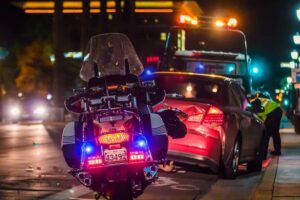Car accidents can be scary and confusing. The best time to plan for an accident is before it happens. That way, you’re prepared with the right questions and can better position yourself if a negligent driver hits you.
Like a journalist, your job is to answer the who, what, where, when, and why of the accident. The sooner you can get this information the better. Details change in our minds over time. Evidence gets contaminated. Witnesses disappear. Getting answers to these key questions can change the course of your personal injury claim.

(Matt C/unsplash)
Who?
Ask yourself who was involved in or witnessed the car wreck and who assisted with the investigation and recovery efforts afterward. Use this short list to prompt you and gather the following information.
- Other Driver(s): If there are more than two cars, you must get everyone’s driving information. The quickest way is to take a picture of their driver’s license and insurance card with your phone. If you can’t do that, get names, contact phone numbers and addresses, driver’s license number, insurance policy number, and license plate and/or vehicle identification number.
- Passengers: Passengers are both witnesses and possible claimants if they are injured or their property is damaged in the crash. Get names, ages, contact phone numbers, and addresses.
- Witnesses: If drivers or pedestrians stop, try to get witness information, including names and contact information.
- Police Officers: If a police officer takes a report, get the name and badge number of the officers on the scene and the report number.
- Tow Company: If your vehicle gets towed from the scene, get the address and phone number of the tow yard or body shop where they will take the vehicle.
What?
Find out exactly what happened to cause the accident and how it happened.
Accident Account: Write a detailed account of the accident as soon as possible after the accident. Don’t embellish or make assumptions, but include everything you witnessed. The more detailed you are now, the better. If the case goes to court and you’re sitting in a witness chair two years from now, you want to have all of that information at hand so you don’t have to rely on your memory.
Vehicle Damage: Part of finding out exactly what happened is documenting the damage to the vehicles. Use your cell phone camera. Get each vehicle from all four corners and the interior so the pictures show every angle.
Injuries: What happened to the people in the car during the accident? To find out, learn more about the injuries of those involved in the crash. You will want to document injuries for all passengers and drivers as soon as you can after the accident. Pictures, in conjunction with medical records, will support your claim for compensation of medical bills. You can’t document internal damage with photographs, but a head wound also corroborates a neck injury. It’s better to have too many pictures than not enough.
Where?
Asking questions about where the accident occurred can help you reconstruct the chain of events that caused the crash.
Accident Site Information: The more specific you can get in your questions about the location, the better. For example,
- “I was turning onto Maple” gives a general location.
- “I was in the left turn lane of a three-lane road headed east on Aspen turning north onto Maple” gives the court a clear picture of how you were situated when the accident occurred and possible obstacles you might have faced.
You can draw a picture. You can also take pictures of the road from all directions and photograph the vehicles after the crash to show where and at what angle the vehicles collided.
When?
Asking about the timing of the accident can yield important details. Document the exact time of the car crash. You can also document the timing of your injuries, such as when your injuries became evident and when you had them examined and treated.
Log the “when” of the ongoing effects of your injuries. For example, when were your therapy appointments, when did you have to miss work for your injuries, when did you have to get childcare while you attended your doctor appointments, when did your pain worsen, etc.
Why?
By asking why, you can drill down to exactly what caused the accident.
Take special note of any circumstances that contributed to the accident:
- Was there clear visibility, or was it dark, snowing, or foggy?
- Was the road in good condition, under construction, or icy?
- Did an animal dart in front of the other vehicle, or was the road unobstructed?
- Was the other driver swerving to avoid another collision?
- Were street signs clearly visible?
- Were large vehicles parked on the corner that limited visibility?
If there were mitigating circumstances, like street signs that weren’t visible, other parties may be at fault.
Your Las Vegas auto accident attorney can sort through the information and help you fill in the holes. As a general rule, the more questions you can ask and answer, the better the outcome of your case.
